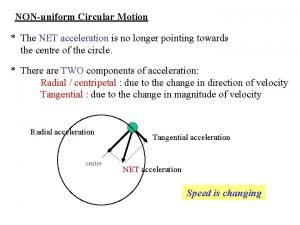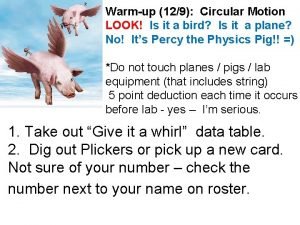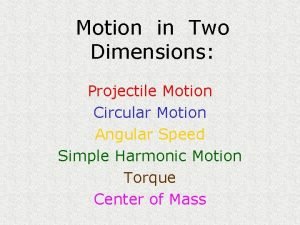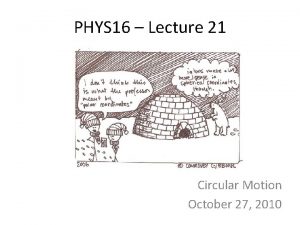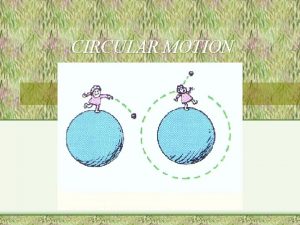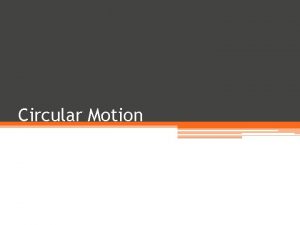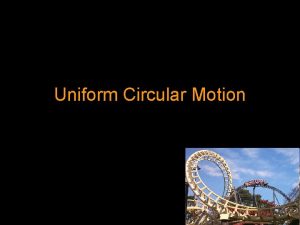Circular Motion Tangential Angular Acceleration Tangential Acceleration The







- Slides: 7

Circular Motion Tangential & Angular Acceleration • Tangential Acceleration: The arc length s is related to the angle q (in radians = rad) as follows: The tangential velocity vt is related to the angular velocity w as follows: Tangential Velocity The tangential acceleration at is related to the angular acceleration a as follows: (radians/s 2) • Overall Acceleration: Tangential Acceleration Radial Acceleration Rick Field 2/7/2013 University of Florida PHY 2053 1

Angular Equations of Motion • Angular Equations of Motion (constant a): If the angular acceleration a is constant then (m/s 2) (radians/s) (m/s) (radians) (m/s 2) Tangential Acceleration Radial Acceleration Rick Field 2/7/2013 University of Florida PHY 2053 2

Angular Equations of Motion • Angular Equations of Motion (constant a): Let N = Number of revolutions (rev) Let f = Number of revolutions per second (rev/s 2) (rad/s) (rev/s) (rad) Rick Field 2/7/2013 University of Florida (frequency) (rev) PHY 2053 3

Angular Equations: Examples • A disk rotates about its central axis starting from rest at t = 0 and accelerates with constant angular acceleration. At one time it is rotating at 4 rev/s; 60 revolutions later, its angular speed is 16 rev/s. Starting at t = 0, what is the time required to complete 64 revolutions? Answer: t = 8 seconds • An astronaut is being tested in a centrifuge. The centrifuge has a radius R and, in starting from rest at t = 0, rotates with a constant angular acceleration a = 0. 25 rad/s 2. At what time t > 0 is the magnitude of the tangential acceleration equal to the magnitude of the radial acceleration (i. e. centripetal acceleration)? Answer: t = 2 seconds Rick Field 2/7/2013 University of Florida PHY 2053 4

Exam 2 Spring 2011: Problem 2 • A race car accelerates uniformly from a speed of 40 m/s to a speed of 58 m/s in 6 seconds while traveling around a circular track of radius 625 m. When the car reaches a speed of 50 m/s what is the magnitude of its total acceleration (in m/s 2)? Answer: 5 % Right: 49% Rick Field 2/7/2013 University of Florida PHY 2053 5

Gravitation: Circular Orbits (M >> m) For circular orbits the gravitational force is perpendicular to the velocity and hence the speed of the mass m is constant. The force Fg is equal to the mass times the radial (i. e. centripetal) acceleration as follows: (radius of the orbit, constant) Assume M >> m so that the position of M is fixed! (speed, constant) (angular velocity, constant) For circular orbits r, v, and w are also constant. (period of rotation) In general both masses rotate about the center-of-mass and the formulas are more complicated! • Kepler’s Third Law: The period squared is proportional to the radius cubed. Rick Field 2/7/2013 University of Florida PHY 2053 6

Circular Orbits: Examples • Two satellites are in circular orbit around the Earth. The first satellite has mass M 1 and is travelling in a circular orbit of radius R 1. The second satellite has mass M 2 = M 1 is travelling in a circular orbit of radius R 2 = 4 R 1. If the first satellite completes one revolution of the Earth in time T, how long does it take the second satellite to make one revolution of the Earth? Answer: 8 T • Two diametrically opposed masses m revolve around a circle of radius R. A third mass M = 2 m is located at the center of the circle. What is the period T of rotation for this system of three masses? Answer: Rick Field 2/7/2013 University of Florida PHY 2053 7



